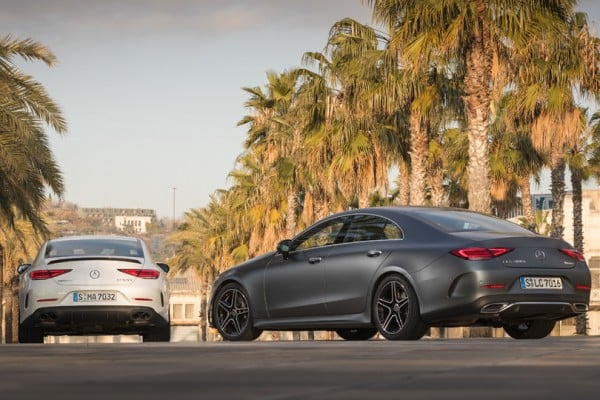When the Mercedes CLS was first launched back in 2005, it didn’t exactly set my world on fire. It was rather unique looking, to use the politest word I could think of, but I just couldn’t tell what or whom it was for exactly. If you want a coupe, you could buy a coupe. If you want to have four doors, well there’s the sedan for that. Of course the CLS then went on to be so successful that Audi and BMW entered the segment with their A7 and 6 series Gran Coupe respectively. Now that I got to drive the all-new third generation of the CLS, maybe I’m finally starting to see what they were on about.
Cars like the CLS are the answer to the difficult question of how to combine practicality with a hint of sexiness. You can’t beat the classic coupe shape for looks, but the way most people’s lives work it’s just not very practical to have only two doors to access both front and rear seats. It’s one of those things that you tend to learn the hard way, as you only really notice how often you use the back doors of a car when they’re not there anymore. Anyway, with the CLS Mercedes figured they would solve that by giving a coupe four doors. Obvious, I know, but that was the easy part. The hard part lies in making the resulting car actually look better than the sedan version. In my personal opinion, which evidently isn’t very representative, every single manufacturer who tried it failed the first time around. But as with most things, they have certainly gotten a lot better at it over time. With the newest CLS, I think they’ve pretty much nailed it. It’s a very good looking car, from every angle that I could find. The proportions are just right. It feels about E-class sized, which it actually is I sup-pose. Room in the back is plentiful in all directions except perhaps the vertical one, as the low roof line inevitably restricts headroom somewhat. My head and I did fit in the back of the CLS, just about, but then I’m 1.93 which is well above average height. Unless you regularly transport profes-sional basketball players I don’t think it’s ever going to be an issue.
![]()
Let’s jump right into the deep end and start with the Mercedes-AMG CLS 53 first. Car journalists tend to jump on the most powerful versions first, with an enthusiasm almost as great as the one with which they descend on a mid-test buffet lunch, and in this case I was no exception as I jumped on the fastest car there. It’s a very interesting one for a couple of reasons, most of which are related to the new engine. It uses an all new 3 litre engine, the first straight six they’ve built this century, and on a technical level it’s hugely complex. It has one regular turbocharger driven by the exhaust gas-es, an electric compressor and on top of that also a mild hybrid system where an electric motor simultaneously acts as starter, alternator and energy recovery device. This 48 Volt integrated start-er/generator (ISG) actually lives in between the engine and gearbox from where it can deliver the «EQ boost» of up to 22 horsepower and 250 Nm of torque for better response at low engine RPM. The CLS 53 is the first Mercedes-AMG to have any form of hybrid powertrain, but the EQ boost system is also being carried over to many other engines in regular Mercedes-Benz models. Given how successful the marque has been in the hybrid era of Formula one, it obviously makes a lot of sense and there is no doubt that we’ll see even more of it going forward.
![]()
As the number 53 suggests, the engine’s output sits in between the AMG «43» V6 and «63» V8 en-gine. The 53’s inline 6 engine generates four hundred and thirty horsepower to be exact. All that punch is transferred onto the road through a 9-speed gearbox and the 4Matic+ all-wheel-drive sys-tem. It’s heavily rear-wheel biased which means it only starts to send large amounts of power to the front once the rear tires lose traction. Unlike in the E 63, though, there is no possibility to make the car rear wheel drive only for those infantile drifting and burnout exercises. I’m entirely fine with that. When asked, Mercedes engineers suggested that the move away from V6 back to inline 6 engines is essentially because the latter is easier to package this way, with the exhaust driven turbocharger as close as possible to the exhaust ports for maximum efficiency.
![]()
In terms of sound and general character I’ve always preferred inline six engines, a configuration which have an perfect balance of the rotating assembly. I think the new engine sounds really good, though inevitably the sound you get is all coming from the exhaust in the back. The obvious comparison would be BMW’s turbo-charged 3 litre straight six as it is found in the M2 and M3, and I think Mercedes-AMG definitely has the better of it sound wise and in terms of responsiveness, as well it should with all that technology under the bonnet of course.
![]()
The CLS 53 will hit 100 kilometres per hour from a dead stop in four and a half seconds, almost ir-regardless of road conditions — as long as it’s not snowing, obviously. The car I drove was fitted with rather aggressive Yokohama Advan Sport summer tires and the level of grip on offer was pretty much outer-worldly for a car of this size and weight. The CLS, by the way, weighs just about two tons. Two thousand kilograms, as near as makes no difference anyway, and that’s before you add your own weight to it when you get in. I was quite shocked by that number as it never felt even re-motely that heavy when throwing the car around on some very tight mountain roads. I would’ve guessed perhaps around 1800 kilograms, while taking into account the fact that modern suspen-sions have become incredibly good at making cars handle like they’re a lot lighter.
![]()
Then again all that luxury and comfort on the inside isn’t going to be light. Even so, trying to find the limit of lateral grip was an exercise in futility, as I struggled to even make the the tires squeel a little while carrying absurd amounts of speed into tight corners. The steering has a lovely weight to it but I did find it hard to get any feeling through the steering wheel of where the limit of tire adhesion really was. It’s still incredibly accurate and responsive, but not much information filtered through to my hands and arms, something that is a bit of a trend with modern power steering systems on most cars though. On a public road, going fast enough to find it would have been rather irresponsible, truth be told. It would’ve been easier on a racetrack but then this car just isn’t meant for that at all.
![]()
On the inside, the CLS 53 is a stunning combination of sportiness and luxury. The seats are very nicely bolstered but still easy to get in and out, and the steering wheel is half-leather with grippy al-cantara at the 3 and 9 o’clock positions and a centre mark at the top. The suspension is also notice-ably firmer and gives the car an overall purposeful feeling that is actually really rather special. It goes without saying that there is more volume coming out of the exhaust, which uses flaps that open automatically when you select Sport or Sport+ mode to switch between quiet and less quiet operation. At no point does the car become shouty though, even going full chat down a small road it remains remarkably dignified. Still, when you use the paddles to drop down a few gears and let the straight six sing its song on part throttle between, say, 4 and 6 thousand RPM, the soundtrack is re-ally rather good. The 9-speed gearbox is a regular automatic, not a dual clutch unit, but the speed with which it shifts can only be described as very quick indeed. In Sport+ mode the shifts do be-come somewhat unnecessarily harsh, so I’d keep it in Sport mode myself where it was pretty much perfect.
![]()
Moving into a CLS 450, which has pretty much the same engine as the CLS 53 only with «only» 362 horsepower in this variation. Not that this makes it slow by any means. It’s still good for a zero to 100 kilometres per hour sprint in under 5 seconds. When I found myself in the CLS 450 behind an enthusiastically driven CLS 53, some direct comparison ensued and in a straight line the AMG car only very slightly pulled away. Of course, if you go onto the German Autobahn and floor the cars for several minutes the more powerful car would create a considerable gap eventually. But on a twisty roads with short straight lines that gave us only seven or eight seconds of acceleration that 53 was simply not escaping the and more quiet and refined 450.
![]()
Perhaps even more interesting were the CLS 350 and 400 diesels. Also getting a new straight six engine, but in diesel form, these represent the most efficient and therefore sensible engine choices for the CLS. But that doesn’t mean you’re missing out on any of the fun. The 340 horsepower CLS 400 d in particular did not feel the lesser when compared to the 450 petrol car. On the contrary, the 400d has so much torque at lower engine speeds that it feels the more powerful of the two in regu-lar driving. Only when you keep your right foot planted with gearshifts at redline does the greater top end power of the petrol car become slightly apparent. It’s the best diesel engine I’ve ever driven, full stop. The 350 d, as you would expect, is the same engine at a somewhat lesser power level so the sound and refinement are of the same high level as its stronger brother. They really are sub-lime.
![]()
The one engine I didn’t yet get to try was the new 4-cylinder which was not yet certified for produc-tion so the power level is still unknown except for the fact that it will be above 300 horsepower. The Mercedes guys were adamant that it, also, is a great engine even though four cylinder motors have not traditionally been associated with premium models. We’ll have to wait and see, but if the prom-ised qualities of that engine turn out to be real then it’s probably going to be a popular option espe-cially for people in countries where engine displacement is heavily taxed.
It goes without saying that the inside of the new CLS feels very upmarket indeed. The materials ex-ude quality and the fit and finish is second to none. The coolest part, though, are the new air vents. I’m not sure why no-one has thought of this before (of if they have, I haven’t noticed) but incorpo-rating LED mood lights in the circular vents is a great touch. They change colour depending on the temperature of the air coming out of them, so blue is for cold, red is for warm and green for what-ever is in the middle I guess. It makes you almost want to wait until it gets dark to drive the car, it really pleases one’s inner twelve-year-old. Gimmicks aside, the cabin lighting in general is great and creates a very nice atmosphere. It’s the little things that make the most difference, as usual.
![]()
By now, it’s abundantly clear that four door coupes are here to stay. If they’re as good as Mer-cedes’ new CLS, then that’s not a bad thing at all. You’ll make a proper entrance when you show up in it, and even the AMG variant is rather restrained and understated in its design. There’s nothing too shouty about it, which I like. These cars are also brimming with cutting edge technology inside and out, but the engineers have managed to keep it nicely in tune with human intuition and our ana-log ways of driving. The move from V6 to straight six engines was a little unexpected, but a pleas-ant surprise nonetheless. They are better than ever. I guess that’s the conclusion that way most re-views of a newly launched Mercedes inevitably end with, so much for any plot twists. But it’s worth mentioning that, probably for the first time ever, I really felt at home driving a Mercedes. Admitted-ly, it was the slightly overkill CLS 53 with the AMG badge, but still. I’m not sure what’s in the Stuttgart air these days, but Mercedes is now making some of, if not the most dynamic driving cars of the segment. I may not have seen that coming, but I certainly do welcome it. More, please.









